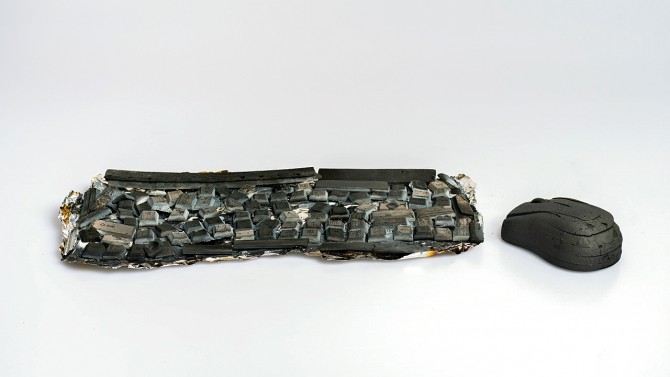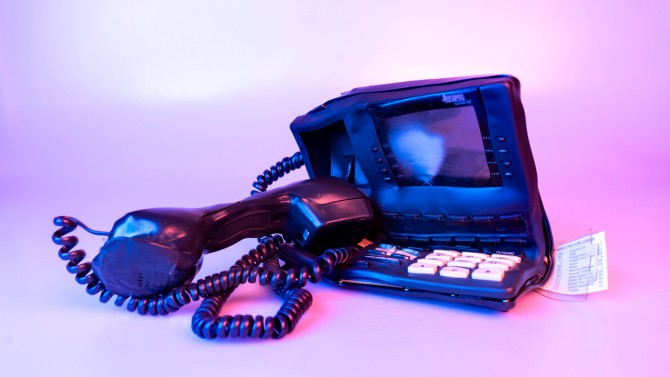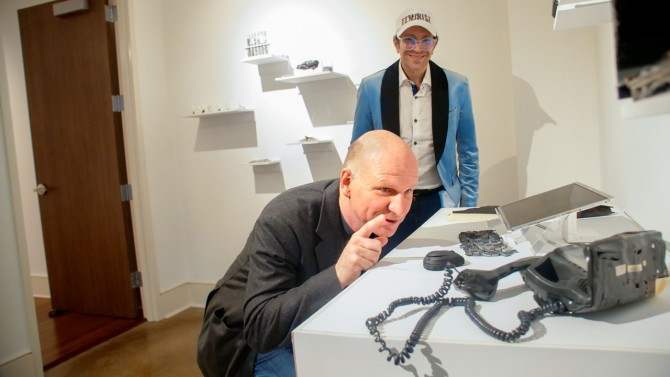
Nathaniel Stern ’99, left, and Johannes Lehmann, professor of soil and crop sciences, with the cybernatural installation “The Wall After Us,” part of “The World After Us” exhibition.
Lehmann, alum artificially age tech waste for new exhibit
By Daniel Aloi
Millions of years from now, long after mankind ceases to exist, what will the technology we use every day look like? What happens to all the devices and digital media we leave behind? Are there ways we can plan for and enable a different future?
Artist Nathaniel Stern ’99 is posing these questions in dramatic ways with “The World After Us: Imaging techno-aesthetic futures,” an exhibition through March 29 at the Museum of Wisconsin Art in Milwaukee.
It includes installations, sculptures, prints and photographs featuring plant life growing from electronic waste, and various media and devices – such as books and floppy disks, cellphones, laptops, keyboards, punch cards, audiotape, and Ethernet and USB cables – altered to resemble fossils.
“You’re taught early on that data is bottomless, just ones and zeros,” Stern said. “And it’s gone if that information is lost, but the logical fallacy is that it is divorced from some material form. That is problematic in many ways. We’re constantly talking about sustainability and green environments, and we don’t take into account the matter around us.”
Stern combined scientific experimentation with artistic exploration to create the traveling exhibition.
“I’ve worked with a botanist and horticulturists to figure out how to grow the plants inside the electronics,” he said. “My first thought was, ‘Were the electronics going to impact the plants?’ In time I found out the inverse is true; the plants would filter out the toxins.”
He also collaborated with Johannes Lehmann, professor of soil and crop sciences in the College of Agriculture and Life Sciences’ School of Integrative Plant Science. They worked together on campus last summer to apply experimental pyrolysis techniques to burn and artificially age the items.
“He started sending me things early in 2019, anything that he could find, intrigued to see what it would look like if we artificially aged it,” Lehmann said. “Apart from the fact we do it in 20 minutes rather than 5 million years, we wanted to see what a book, or a cellphone, would look like in millions of years.”
He wouldn’t normally think of the longevity of materials put in soil “past more than a few thousand years,” Lehmann said. “I don’t think in iPhones; I think in plants and leaves. This idea is so intriguing. Our nose gets poked into questions that we didn’t ask before.”
Stern reached out to scientists working with fossil fuels and aging, and most didn’t write back, he said. His classmate and friend Julie Goddard ’99, Ph.D. ’08, associate professor of food science, told Stern about Lehmann’s work with biochar, superheated organic material used to enrich soil.
“Literally within hours of phoning Johannes, he said, ‘Let’s meet today,’” Stern said. “I was amazed how similar his lab tests and my studio tests are, how we label things … We work in much the same way.”
The artist worked with a forge and foundry to work out how to convert aluminum iMacs into tools; and [with Lehmann and Jessica Meuninck-Ganger of the University of Wisconsin] to turn phones into inks and make prints.
Stern has an experimental art background and began work on the project in 2016. Applying for a fellowship studying theory in the eschaton – the end of days – “gave me the idea for the fossils, and the degradation over geologic time of technological material,” Stern said. “I didn’t get the fellowship; however, the director of the center [political theorist Kennan Ferguson] reached out and said it was a great idea. He wound up becoming one of the catalog essayists on the show.”
Stern said he’s been playing around with technology for more than 20 years. “At Cornell, we were the only fashion program around that was doing things like 3D scanning and pattern grading,” he said. “It’s where I learned that you could be creative with technology. My interactive art comes from that basis in fashion.”
After graduating from the College of Human Ecology, he returned to Cornell in 2002 as an artist-in-residence at Risley Residential College, and earned graduate degrees in art from New York University and electrical engineering from Trinity College in Dublin. Stern now holds a joint appointment as professor of art and design and of mechanical engineering at the University of Wisconsin, Milwaukee.
Stern wants to explore the potential for change in recycling practices and the regulation of waste, beginning with how we perceive the products we throw away by the millions.
“Many people understand the problem of waste and of toxicity,” he said. “There’s this intimate relationship we have with our technology; can we keep that relationship just one year longer? … Can we make biodegradable or compostable phones?”
“Artists are starting to imagine these things,” Lehmann said. “They ask the uncomfortable questions about our future and our society.”
Media Contact
Get Cornell news delivered right to your inbox.
Subscribe



